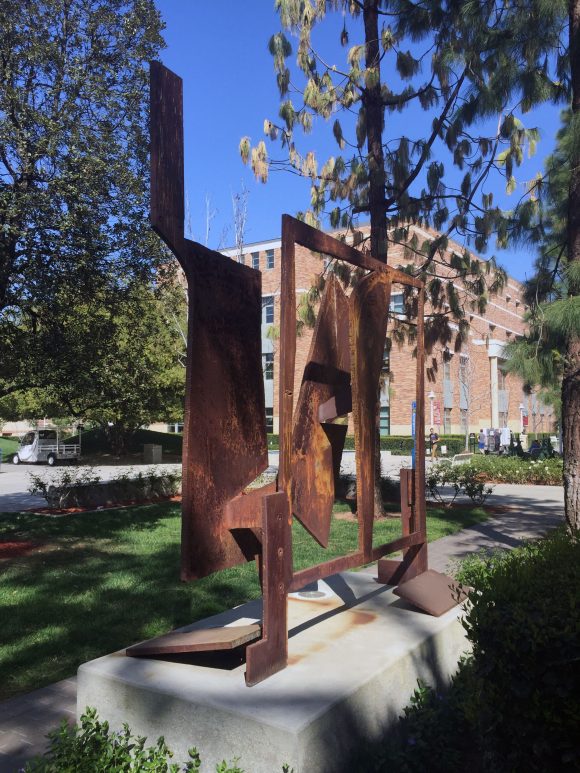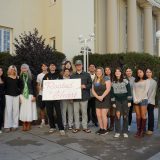Ancestry and Empathy William Wareham's Ancestors I
March 28, 2017
Located on a pathway between Irvine Lecture Hall and Moulton Hall, William Wareham’s Ancestors I has an authoritative presence. The sculpture, a rigid manipulation of rusted steel, rests against a backdrop of brick and ivy, offering an industrial element to its natural environment. From a frontal perspective, the piece is roughly square and appears to be two-dimensional. A closer look at the work’s structure reveals that the majority of it was created from a single sheet of steel, with rectangular shapes protruding from a recessed background. Because this three-dimensionality is only accessible through a different, non-frontal view, the piece encourages active engagement and viewership from multiple angles. A side view of the sculpture shows the smooth bends where the rectangular cutouts extend beyond the basic plane. These bends are the only connections between the foreground and background–the cutouts are simultaneously pushed forward while held back, creating a forward-moving propulsion. Perhaps it is this limited but powerful connection that represents the conversation between past and present: we draw on our ancestry to shape our contemporary identity.

Back view of Ancestors I, William Wareham, 1982. Welded varnished steel. Escalette Permanent Collection of Art.
Wareham is known for his use of recycled materials, and describes how he is inspired by the “pre-used history that the material inherently holds…These worn-out metal things will continue to have a life by gathering, refocusing and rejoining into a collective other life”. The title of the work, Ancestors, indicates a consciousness of what comes before us, of our heritage. In the same way, Wareham’s use of recycled steel evokes notions of use and reuse, prompting questions about the materials’ own heritage and previous use. This recycled quality is intensified by the work’s lack of paint—though it is varnished, the steel is rusted throughout. The rust continues beyond the sculpture as well, extending onto the cement platform. This element of decay only adds to the effect of the piece. As it blends and melts into its environment, the work creates an additional ancestral narrative.
Warham says about his work:
“On my studio wall is a small sign (the lettering disappearing from age) that says: ‘Do not be afraid!’ Perhaps intended as a morale booster to those WWII sailors going off to war from this shipyard: it now acts as an aesthetic reminder to pursue the creative act with vigour. But what is that? Is it to take three-dimensional form to where it has not been before or mine the turf that others have excavated in the belief of finding new harmonies? Whichever path, to activate space with steel is a challenge. I try to resolve this with both knowledge and intuition asking myself constantly; “Is this solution too predictable?” I rework and change the forms to get a more dynamic relationship, interesting intervals, tension in the negative volumes or contrasting scale; all with the purpose of bringing a great sense of visual delight to our lives.”
Wareham’s consciousness of predictability, dynamics, and tension translate easily to Ancestors. Though the steel work is rigid in material and form, it remains exciting and unpredictable. The sculpture is transient: its effect is entirely dependent on the viewer’s perspective, both physical and mental.
How does the sculpture’s rusted steel and rigid form activate the viewer’s space? Is Ancestors I complimented by its environment? Does the piece stand out, or does it blend in?
Ancestors I asks the viewer these questions, facilitating a discussion between sculpture and audience. Is there a way for the viewer to relate to a steel structure like this? The title is the bridge which puts a name to the viewer’s relationship with the sculpture. “Ancestors” creates a bond between art and man—by giving a stationary, lifeless object the humanistic element of heritage, it fosters an empathetic experience.

Detail of Ancestors I, William Wareham, 1982. Welded varnished steel. Escalette Permanent Collection of Art.
To schedule a tour with the Art Collections, please contact artcollections@chapman.edu. For more information about the artist, visit his website: www.williamwareham.com
All text and images under copyright. Please contact artcollections@chapman.edu for permission to use. Information subject to change upon further research.



